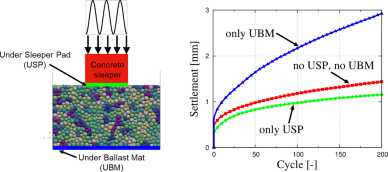当前位置:
X-MOL 学术
›
Granular Matter
›
论文详情
Our official English website, www.x-mol.net, welcomes your
feedback! (Note: you will need to create a separate account there.)
Micro-mechanical investigation of railway ballast behavior under cyclic loading in a box test using DEM: effects of elastic layers and ballast types.
Granular Matter ( IF 2.3 ) Pub Date : 2019-10-24 , DOI: 10.1007/s10035-019-0956-9 Nishant Kumar 1 , Bettina Suhr 1 , Stefan Marschnig 2 , Peter Dietmaier 3 , Christof Marte 1 , Klaus Six 1

中文翻译:

使用 DEM 进行箱式试验中循环载荷下铁路道碴行为的微观力学研究:弹性层和道碴类型的影响。
 更新日期:2019-10-24
更新日期:2019-10-24
Granular Matter ( IF 2.3 ) Pub Date : 2019-10-24 , DOI: 10.1007/s10035-019-0956-9 Nishant Kumar 1 , Bettina Suhr 1 , Stefan Marschnig 2 , Peter Dietmaier 3 , Christof Marte 1 , Klaus Six 1
Affiliation
Abstract
Ballasted tracks are the commonly used railway track systems with constant demands for reducing maintenance cost and improved performance. Elastic layers are increasingly used for improving ballasted tracks. In order to better understand the effects of elastic layers, physical understanding at the ballast particle level is crucial. Here, discrete element method (DEM) is used to investigate the effects of elastic layers – under sleeper pad (\(\text {USP}\)) at the sleeper/ballast interface and under ballast mat (\(\text {UBM}\)) at the ballast/bottom interface – on micro-mechanical behavior of railway ballast. In the DEM model, the Conical Damage Model (CDM) is used for contact modelling. This model was calibrated in Suhr et al. (Granul Matter 20(4):70, 2018) for the simulation of two different types of ballast. The CDM model accounts for particle edge breakage, which is an important phenomenon especially at the early stage of a tamping cycle, and thus essential, when investigating the impact of elastic layers in the ballast bed. DEM results confirm that during cyclic loading, \(\text {USP}\) reduces the edge breakage at the sleeper/ballast interface. On the other hand, \(\text {UBM}\) shows higher particle movement throughout the ballast bed. Both the edge breakage and particle movement in the ballast bed are found to influence the sleeper settlement. Micro-mechanical investigations show that the force chain in deeper regions of the ballast bed is less affected by \(\text {USP}\) for the two types of ballast. Conversely, dense lateral forces near to the box bottom were seen with \(\text {UBM}\). The findings are in good (qualitative) agreement with the experimental observations. Thus, DEM simulations can aid to better understand the micro-macro phenomena for railway ballast. This can help to improve the track components and track design based on simulation models taking into account the physical behavior of ballast.Graphical Abstract

中文翻译:

使用 DEM 进行箱式试验中循环载荷下铁路道碴行为的微观力学研究:弹性层和道碴类型的影响。
摘要
有砟轨道是常用的铁路轨道系统,不断要求降低维护成本和提高性能。弹性层越来越多地用于改善有砟轨道。为了更好地理解弹性层的影响,对压载粒子水平的物理理解至关重要。在这里,离散元法 (DEM) 用于研究弹性层的影响——在轨枕/道砟界面处的轨枕垫 ( \(\text {USP}\) ) 和道砟垫 ( \(\text {UBM} \)) 在道碴/底部界面——关于铁路道碴的微观力学行为。在 DEM 模型中,锥形损伤模型 (CDM) 用于接触建模。该模型在 Suhr 等人中进行了校准。(Granul Matter 20(4):70, 2018)用于模拟两种不同类型的镇流器。CDM 模型考虑了颗粒边缘断裂,这是一个重要的现象,尤其是在捣固周期的早期阶段,因此在研究道碴床弹性层的影响时是必不可少的。DEM 结果证实,在循环加载过程中,\(\text {USP}\)减少了轨枕/道砟界面处的边缘破损。另一方面,\(\text {UBM}\)在整个道碴床中显示出更高的粒子运动。发现道碴床的边缘破损和颗粒运动都会影响轨枕沉降。微观力学研究表明,两种道碴对道碴床较深区域的力链受\(\text {USP}\)的影响较小。相反,使用\(\text {UBM}\)可以看到靠近盒子底部的密集侧向力。研究结果与实验观察结果良好(定性)一致。因此,DEM 模拟有助于更好地理解铁路道砟的微观宏观现象。这有助于改进基于仿真模型的轨道组件和轨道设计,同时考虑到道碴的物理行为。图形概要








































 京公网安备 11010802027423号
京公网安备 11010802027423号